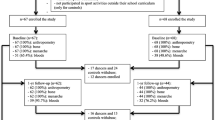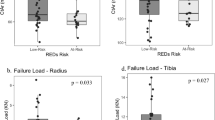Abstract
Summary
Three years of study showed that female and male vocational dancers displayed lower bone mass compared to controls, at forearm, lumbar spine and femoral neck. Energy intake was found to positively predict bone mass accruals only in female dancers at femoral neck. Vocational dancers can be a risk population to develop osteoporosis.
Purpose
To determine whether risk factors normally associated with low bone mass in athletic populations (i.e. nutrition intake, energy expenditure and energy availability) are significant predictors of bone mass changes in vocational dance students.
Methods
The total of 101 vocational dancers (63 females, 12.8 ± 2.2 years; 38 males, 12.7 ± 2.2 years) and 115 age-matched controls (68 females, 13.0 ± 2.1 years; 47 males, 13.0 ± 1.8 years) were monitored for 3 consecutive years. Bone mass parameters were measured annually at impact sites (femoral neck, FN; lumber spine, LS) and non-impact site (forearm) using DXA. Nutrition (3-day record), energy expenditure (accelerometer), energy availability and IGF-1 serum concentration (immunoradiometric assays) were also assessed.
Results
Female and male vocational dancers had consistently reduced bone mass at all anatomical sites (p < 0.001) than controls. IGF-1 did not differ between male vocational dancers and controls, but female dancers showed it higher than controls. At baseline, calcium intake was significantly greater in female vocational dancers than controls (p < 0.05). Male vocational dancers’ fat and carbohydrate intakes were significantly lower than matched controls (p < 0.001 and p < 0.05, respectively). Energy availability of both female and male vocational dancers was within the normal range. A significant group effect was found at the FN regarding energy intake (p < 0.05) in female dancers. No significant predictors were found to explain bone mass differences in males.
Conclusion
Our 3-year study revealed that both female and male vocational dancers displayed lower bone mass compared to controls, at both impact and non-impact sites. The aetiology of these findings may be grounded on factors different than those usually considered in athletic populations.


Similar content being viewed by others
Data availability
All data and material are real and available if it is requested.
Code availability
Not applicable.
References
Feng X, McDonald JM (2011) Disorders of bone remodeling. Annu Rev Pathol 6:121–145. https://doi.org/10.1146/annurev-pathol-011110-130203
Cummings SR, Black DM, Nevitt MC, Browner W, Cauley J, Ensrud K, Genant HK, Palermo L, Scott J, Vogt TM (1993) Bone density at various sites for prediction of hip fractures. Lancet 341(8837):72–75. https://doi.org/10.1016/0140-6736(93)92555-8
Melton LJ, Atkinson EJ, O’Fallon WM, Wahner HW, Riggs BL (1993) Long-term fracture prediction by bone mineral assessed at different skeletal sites. J Bone Miner Res 8(10):1227–1233. https://doi.org/10.1002/jbmr.5650081010
Holroyd C, Cooper C, Dennison E (2008) Epidemiology of osteoporosis. Best Pract Res Clin Endocrinol Metab 22(5):671–685. https://doi.org/10.1016/j.beem.2008.06.001
Myszkewycz L, Koutedakis Y (1998) Injuries, amenorrhea, and osteoporosis in active females: an overview. J Dance Med Sci 2:88–94
Robson B, Chertoff A (2010) Bone health and female dancers:physical and nutritional guidelines. Int Assoc Dance Med Sci: 1–4. Available from: https://fusionartsphysicaltherapy.com/bone-health-and-female-dancers-physical-nutritional-guidelines/
Doyle-Lucas AF, Akers JD, Davy BM (2010) Energetic efficiency, menstrual irregularity, and bone mineral density in elite professional female ballet dancers. J Dance Med Sci 14(4):146–154
Burckhardt P, Wynn E, Krieg MA, Bagutti C, Faouzi M (2011) The effects of nutrition, puberty and dancing on bone density in adolescent ballet dancers. J Dance Med Sci 15(2):51–60
Valentino R, Savastano S, Tommaselli AP, D’Amore G, Dorato M, Lombardi G (2001) The influence of intense ballet training on trabecular bone mass, hormone status, and gonadotropin structure in young women. J Clin Endocrinol Metab 86(10):4674–4678. https://doi.org/10.1210/jcem.86.10.7908
Keay N, Fogelman I, Blake G (1997) Bone mineral density in professional female dancers. Br J Sports Med 31(2):143–147. https://doi.org/10.1136/bjsm.31.2.143
Nattiv A, Loucks AB, Manore MM, Sanborn CF, Sundgot-Borgen J, Warren MP (2007) American College of Sports Medicine position stand: the female athlete triad. Med Sci Sports Exerc 39(10):1867–1882. https://doi.org/10.1249/mss.0b013e318149f111
Mountjoy M, Sundgot-Borgen J, Burke L, Carter S, Constantini N, Lebrun C, Meyer N, Sherman R, Steffen K, Budgett R, Ljungqvist A (2014) The IOC consensus statement: beyond the female athlete triad: relative energy deficiency in sport (RED-S). Br J Sports Med 48(7):491–497. https://doi.org/10.1136/bjsports-2014-093502
Koutedakis Y, Jamurtas A (2004) The dancer as a performing athlete: physiological considerations. Sports Med 34(10):651–661. https://doi.org/10.2165/00007256-200434100-00003
Locatelli V, Bianchi VE (2014) Effect of GH/IGF-1 on bone metabolism and osteoporsosis. Int J Endocrinol 2014:1–25. https://doi.org/10.1155/2014/235060
Amorim T, Wyon M, Maia J, Machado JC, Marques F, Metsios GS, Flouris AD, Koutedakis Y (2015) Prevalence of low bone mineral density in female dancers. Sports Med 45(2):257–268. https://doi.org/10.1007/s40279-014-0268-5
Amorim T, Metsios GS, Flouris AD, Nevill A, Gomes TN, Wyon M, Marques F, Nogueira L, Adubeiro N, Jamurtas AZ, Maia J, Koutedakis Y (2019) Endocrine parameters in association with bone mineral accrual in young female vocational ballet dancers. Arch Osteoporos 14(46):1–9. https://doi.org/10.1007/s11657-019-0596-z
Mirwald RL, Baxter-Jones AD, Bailey DA, Beunen GP (2002) An assessment of maturity from anthropometric measurements. Med Sci Sports Exerc 34(4):689–694. https://doi.org/10.1097/00005768-200204000-00020
Crawford PB, Obarzanek E, Morrison J, Sabry ZI (1994) Comparative advantage of 3-day food records over 24-hour recall and 5-day food frequency validated by observation of 9- and 10-year-old girls. J Am Diet Assoc 94(6):626–630. https://doi.org/10.1016/0002-8223(94)90158-9
Brazeau AS, Beaudoin N, Bélisle V, Messier V, Karelis AD, Rabasa-Lhoret R (2016) Validation and reliability of two activity monitors for energy expenditure assessment. J Sci Med Sport 19(1):46–50. https://doi.org/10.1016/j.jsams.2014.11.001
Weeks BK, Beck BR (2008) The BPAQ: a bone-specific physical activity assessment instrument. Osteoporos Int 19(11):1567–1577. https://doi.org/10.1007/s00198-008-0606-2
Cardadeiro G, Baptista F, Rosati N, Zymbal V, Janz KF, Sardinha LB (2014) Influence of physical activity and skeleton geometry on bone mass at the proximal femur in 10- to 12-year-old children: a longitudinal study. Osteoporos Int 25(8):2035–2045. https://doi.org/10.1007/s00198-014-2729-y
Farr JN, Lee VR, Blew RM, Lohman TG, Going SB (2011) Quantifying bone-relevant activity and its relation to bone strength in girls. Med Sci Sports Exerc 43(3):476–483. https://doi.org/10.1249/MSS.0b013e3181eeb2f2
Kindler JM, Ross HL, Laing EM, Modlesky CM, Pollock NK, Baile CA, Lewis RD (2015) Load-specific physical activity scores are related to tibia bone architecture. Int J Sport Nutr Exerc Metab 25(2):136–144. https://doi.org/10.1123/ijsnem.2013-0258
Amorim T, Koutedakis Y, Nevill A, Wyon M, Maia J, Machado JC, Marques F, Metsios GS, Flouris AD, Adubeiro N, Nogueira L, Dimitriou L (2017) Bone mineral density in vocational and professional ballet dancers. Osteoporos Int 28(10):2903–2912. https://doi.org/10.1007/s00198-017-4130-0
Amorim T, Metsios GS, Wyon M, Nevill AM, Flouris AD, Maia J, Teixeira E, Machado JC, Marques F, Koutedakis Y (2017) Bone mass of female dance students prior to professional dance training: a cross-sectional study. PLoS ONE 12(7):1–11. https://doi.org/10.1371/journal.pone.0180639
Warren MP, Brooks-Gunn J, Fox RP, Lancelot C, Newman D, Hamilton WG (1991) Lack of bone accretion and amenorrhea: evidence for a relative osteopenia in weight-bearing bones. J Clin Endocrinol Metab 72(4):847–853. https://doi.org/10.1210/jcem-72-4-847
Armann S, Wells C, Cheung S (1986) Bone mass, menstrual abnormalities, dietary intake, and body composition in classical ballerinas. Kinesiol Med Dance 13(1):1–15
Pearce G, Bass S, Young N, Formica C, Seeman E (1990) Does weight-bearing exercise protect against the effects of exercise-induced oligomenorrhea on bone density? Osteoporos Int 6:448–452
Russell JA, Kruse DW, Koutedakis Y, McEwan IM, Wyon MA (2010) Pathoanatomy of posterior ankle impingement in ballet dancers. Clin Anat 23(6):613–621. https://doi.org/10.1002/ca.20991
Angioi M, Metsios GS, Koutedakis Y, Twitchett E, Wyon MA (2009) Physical fitness and severity of injuries in contemporary dance. Med Probl Perform Art 24(1):26–29
Fortes CM, Goldberg TB, Kurokawa CS, Silva CC, Moretto MR, Biason TP, Teixeira AS, Nunes HR (2014) Relationship between chronological and bone ages and pubertal stage of breasts with bone biomarkers and bone mineral density in adolescents. J Pediatr (Rio J) 90(6):624–631. https://doi.org/10.1016/j.jped.2014.04.008
Rantalainen T, Weeks BK, Nogueira RC, Beck BR (2015) Effects of bone-specific physical activity, gender and maturity on tibial cross-sectional bone material distribution: a cross-sectional pQCT comparison of children and young adults aged 5–29 years. Bone 72:101–108. https://doi.org/10.1016/j.bone.2014.11.015
Oral A, Tarakçi D, Disci R (2006) Calcaneal quantitative ultrasound measurements in young male and female professional dancers. J Strength Cond Res 20(3):572–578. https://doi.org/10.1519/r-17915.1
Cuesta A, Revilla M, Villa LF, Hernández ER, Rico H (1996) Total and regional bone mineral content in spanish professional ballet dancers. Calcif Tissue Int 58(3):150–154. https://doi.org/10.1007/bf02526880
Bonewald LF (2011) The amazing osteocyte. J Bone Miner Res 26(2):229–238. https://doi.org/10.1002/jbmr.320
Amorim T, Durães C, Machado JC, Metsios GS, Wyon M, Maia J, Flouris AD, Marques F, Nogueira L, Adubeiro N, Koutedakis Y (2018) Genetic variation in Wnt/β-catenin and ER signalling pathways in female and male elite dancers and its associations with low bone mineral density: a cross-section and longitudinal study. Osteoporos Int 29(10):2261–2274. https://doi.org/10.1007/s00198-018-4610-x
Jepsen KJ (2009) Systems analysis of bone. WIREs Syst Biol Med 1(1):73–88. https://doi.org/10.1002/wsbm.15
Xing W, Baylink D, Kesavan C, Hu Y, Kapoor S, Chadwick RB, Mohan S (2005) Global gene expression analysis in the bones reveals involvement of several novel genes and pathways in mediating an anabolic response of mechanical loading in mice. J Cell Biochem 96(5):1049–1060. https://doi.org/10.1002/jcb.20606
Suuriniemi M, Mahonen A, Kovanen V, Alén M, Lyytikainen A, Wang Q, Kroger H, Cheng S (2004) Association between exercise and pubertal BMD is modulated by estrogen receptor alpha genotype. J Bone Miner Res 19(11):1758–1765. https://doi.org/10.1359/jbmr.040918
Crabtree NJ, Arabi A, Bachrach LK, Fewtrell M, El-Hajj Fuleihan G, Kecskemethy HH, Jaworski M, Gordon CM (2014) Dual-energy X-ray absorptiometry interpretation and reporting in children and adolescents: the revised 2013 ISCD pediatric official positions. J Clin Densitom 17(2):225–242. https://doi.org/10.1016/j.jocd.2014.01.003
Acknowledgements
The authors thank the Portuguese Foundation for Science and Technology for supporting this research (PhD Grant: SFRH/BD/88585/2012). Thanks are also expressed to the radiology services of the Beatriz Angelo Hospital.
Funding
The study was supported by the Portuguese Foundation for Science and Technology (PhD Grant: SFRH/BD/88585/2012).
Author information
Authors and Affiliations
Corresponding author
Ethics declarations
Ethics approval
Study design protocol and consent forms involving human participants were in accordance with the Helsinki Declaration (1964) and approved by the ethics committee of the Regional Administration of Health of Lisbon, Portugal (Proc.063/CES/INV/2012).
Informed consent
Informed consent was obtained from all individual participants included in the study.
Conflicts of interest
None.
Additional information
Publisher's note
Springer Nature remains neutral with regard to jurisdictional claims in published maps and institutional affiliations.
Rights and permissions
About this article
Cite this article
Amorim, T., Freitas, L., Metsios, G.S. et al. Associations between nutrition, energy expenditure and energy availability with bone mass acquisition in dance students: a 3-year longitudinal study. Arch Osteoporos 16, 141 (2021). https://doi.org/10.1007/s11657-021-01005-5
Received:
Accepted:
Published:
DOI: https://doi.org/10.1007/s11657-021-01005-5




